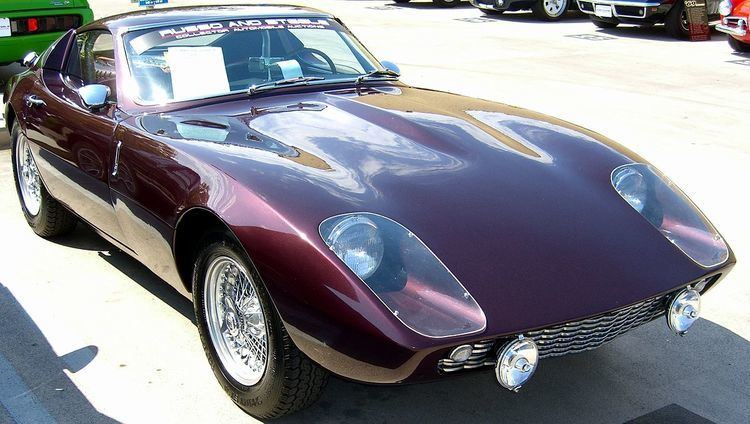 | ||
Fiberfab Velocidad Inc was an American kit car manufacturer founded by Warren "Bud" Goodwin in 1964.
Contents
Warren Goodwin
Goodwin was a former sports-car racer and a keen fisherman, born in 1921 or 1922. His first wife and the mother of his two sons was Gwendolyn.
His earlier company, Sports Car Engineering, had manufactured Microplas Mistral bodies under license and sold them as the Spyder. He founded Fiberfab in 1964. In 1967 Goodwin was arrested on suspicion of murder for shooting his 28-year-old second wife, Jamaica. The police said he had found Jamaica with Farbus Kidoo. Goodwin claimed the shooting was accidental. He was charged with the voluntary manslaughter and sentenced to 12 months' imprisonment. He died in jail on December 26, 1968, of a heart attack.
Ownership and locations up to 1983
Fiberfab started building street rod parts and body panels for Mustangs in Los Angeles before moving on to kit cars. The company moved first to Sunnyvale, and then in 1966 to Santa Clara. It had a branch in West Germany from 1967 until 1973 at Ditzigen. The German company, also named Fiberfab severed its links with the American Fiberfab in 1973, moved to Aunstein, and began to make a jeep style vehicle of its own. It continued to make Bonitos until 1981 when it sold its version to a British Company, ACM.
The American company was still operating at Santa Clara in 1970 after the death of Goodwin. In 1971 Fiberfab was a Division of Concept Design America, a California-based company, ATR Incorporated, a Pennsylvania Corporation, acquired ownership of Fiberfab in November 1974. Around this time the company became named Fiberfab Incorporated.
In 1977 Fiberfab and James Crank's JDEX Company combined to make a steam-powered record attempt car using the Aztec 7 body-kit powered by a LMC Corporation steam engine developed as part the Lear Steam Bus Program. They planned the speed record attempt for August at Bonneville. The car failed to exceed 100 mph and was sold to the Barber-Nichols Engineering Company. Barber-Nicholls rebuilt it. On its first attempt it reached 111 mph. Robert Barber at Bonneville on August 19, 1985 reached 145.607 mph but the car caught fire and was unable to complete its second run. The car is on display at the National Automobile Museum in Reno, Nevada.
By 1979 the company was based at Minneapolis. In 1983 the company was sold to Classic Motor Carriages (at the time Fiberfab Incorporated's largest competitor) and renamed Fiberfab International.
Fiberfab Velocidad era
Prior to 1967 the company made the Aztec, which had the appearance of a coupe version of the Spyder. Fiberfab made a Ford GT40 replica based on a VW Beetle floorpan called Avenger GT in 1964 and in August 1967 the similar Valkyrie designed to take a V8. The Valkyrie won third place in the prototype section of the 1967 New York International Car Show. Don Sherman, editor of Car and Driver magazine from 1985 to 1988 owned and built one of these in the late 1960s.
The Jamaican was also one of Fiberfab's early car bodies. It was designed to be fitted to a TR3, TR4, MGA, Austin-Healey or a Volkswagen Beetle. Later Fiberfab built their own 'Jamaican' chassis for use with a V8 power-plant.
The Bonanza and Bonito were made in the late 1960s. The Bonito was at one point license built in Germany, Sweden, and England. At that time Fiberfab also made a couple of dune buggies the Clodhopper and Vagabond. Production of these ended in about 1970.
Fiberfab Germany
Fiberfab-Karosserie in Germany initially built Aztec, Bonanza and Bonito kit cars. After separating from the American company they built the Fiberfab Sherpa from 1975 based on a Citroën 2CV chassis. The company sold the Bonito rights to an English company ACM in 1981 who called it the ACM Excalibur.
UK manufacturers
ACM then transferred the rights to the Bonito to Seraph Motors who named it the Seraph 3000 in England and made it between 1985 and the early 1990s. Clive Clark's Excalibur and Crusader cars then took over until 1996. As at 2010 WS Motors in England were still able to produce the bodies to order.
Fiberfab Inc era (to 1983)
About 1975 Fiberfab introduced 3 new models including an unusual kit which turned a motor-cycle into a three-wheel car called the Scarab STM. It was made at the company's Baldwin Street, Bridgeville, Pennsylvania plant.
In 1977 the company was advertising a kit-set MG TD replica called the Migi II with a choice of front or rear-wheel drive. In 1983 Fiberfab International advertised a 1929 Mercedes Benz replica. The Mercedes replica was the CMC Gazelle badged as a Fiberfab Car
Classic Motor Carriages/Street Beasts era (1983-2010)
The Speedster cars, based on the Porsche Spyder, were made in the mid to late 1980's.
Fiberfab either built some replica Lola T70's or made modifications to existing models that appeared in the George Lucas science fiction film THX 1138.
Classic Motor Carriages (later Street Beasts)
The company was purchased by Classic Motor Carriages in 1983. Various kitcar forums have comments about the kits provided by Classic Motor Carriages as being among the most difficult to work with. The company was also noted for not providing all the parts in its kits.
Classic Motor Carriages was forced to close in 1994 after the Florida Attorney General's Office filed suit against it on behalf of 900 of its customers. It agreed to pay $2.5 million in compensation. At the same time as the case was proceeding a new company, Auto Resolutions, was set up by the owner George Levin to continue making Classic Motor Carriages vehicles trading under the name Street Beasts. Complaints about its products continued. Street Beasts closed its business in 2010 and auctioned off its plant, moulds, and machinery. In 2011 the molds for the Speedster were for sale on eBay.
Later history
Fiberfab Valkyrie kitcars resumed production in 2003 by a new Fiberfab Company in La Pine, Oregon.
